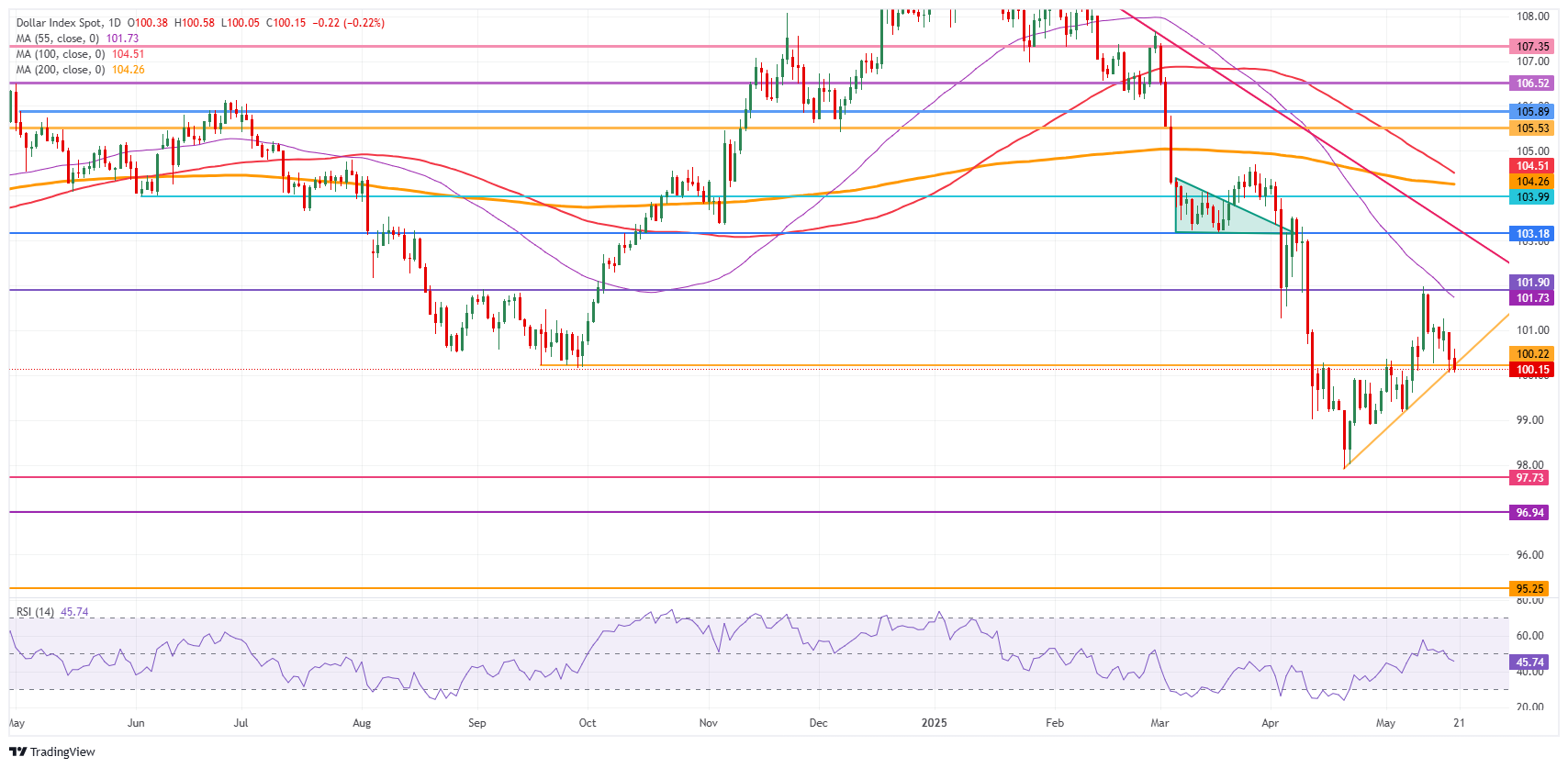Created
: 2025.05.20














![]() 2025.05.20 20:53
2025.05.20 20:53
The US Dollar Index (DXY), which tracks the performance of the US Dollar (USD) against six major currencies, is slipping lower for a second consecutive day on Tuesday as markets continue to digest the recent downgrade of the rating in US debt, which led to a rollercoaster in US bond markets.
Outside the US, geopolitical tensions are picking up again. France, the United Kingdom and Canada are considering sanctions on Israel if the country does not call off its ground offensive in Gaza and allows food supplies to enter the Strip. Israel's Prime Minister Benjamin Netanyahu pushed back by saying that Israel has the right to defend itself.
Regarding the Russia-Ukraine war, EU leaders condemned the retreat of United States (US) President Donald Trump after his two-hour call with Russian President Vladimir Putin. Despite the bold claims that a deal would be brokered within days after becoming President and that a peace deal would not be possible without the US, President Trump said that the US would back out of any further talks by saying "it's not our war to deal with", Bloomberg reported. The unraveling adds to further losing credibility, hitting the value of the US Dollar.
In a relatively calm week in terms of economic data, traders brace for more comments from Federal Reserve (Fed) officials on Tuesday after Monday's mostly hawkish tone seen among many of them.
The US Dollar Index is losing some more of its shine on Tuesday. After the creditworthiness and its safe-haven status issue due to the credit rating downgrade, the fact that President Trump might walk away from any further attempts to end the war between Russia and Ukraine can be perceived as another element of untrustworthiness. The fact that the Trump administration might switch or even U-turn on any matter will stick with trader sentiment when considering how to deal with the US Dollar.
On the upside, 101.90 is the first big resistance again as it already acted as a pivotal level throughout December 2023 and as a base for the inverted head-and-shoulders (H&S) formation during the summer of 2024. The 55-day Simple Moving Average (SMA) at 101.94 reinforces this area as strong resistance. In case Dollar bulls push the DXY even higher, the 103.18 pivotal level comes into play.
As for supports, the ascending trend line and support level at 100.22 is under pressure and could snap at any moment if more selling pressure emerges. A nosedive move could materialize towards the year-to-date low of 97.91 and the pivotal level of 97.73. Further below, a relatively thin technical support comes in at 96.94 before looking at the lower levels of this new price range. These would be at 95.25 and 94.56, meaning fresh lows not seen since 2022.

US Dollar Index: Daily Chart
The US Dollar (USD) is the official currency of the United States of America, and the 'de facto' currency of a significant number of other countries where it is found in circulation alongside local notes. It is the most heavily traded currency in the world, accounting for over 88% of all global foreign exchange turnover, or an average of $6.6 trillion in transactions per day, according to data from 2022. Following the second world war, the USD took over from the British Pound as the world's reserve currency. For most of its history, the US Dollar was backed by Gold, until the Bretton Woods Agreement in 1971 when the Gold Standard went away.
The most important single factor impacting on the value of the US Dollar is monetary policy, which is shaped by the Federal Reserve (Fed). The Fed has two mandates: to achieve price stability (control inflation) and foster full employment. Its primary tool to achieve these two goals is by adjusting interest rates. When prices are rising too quickly and inflation is above the Fed's 2% target, the Fed will raise rates, which helps the USD value. When inflation falls below 2% or the Unemployment Rate is too high, the Fed may lower interest rates, which weighs on the Greenback.
In extreme situations, the Federal Reserve can also print more Dollars and enact quantitative easing (QE). QE is the process by which the Fed substantially increases the flow of credit in a stuck financial system. It is a non-standard policy measure used when credit has dried up because banks will not lend to each other (out of the fear of counterparty default). It is a last resort when simply lowering interest rates is unlikely to achieve the necessary result. It was the Fed's weapon of choice to combat the credit crunch that occurred during the Great Financial Crisis in 2008. It involves the Fed printing more Dollars and using them to buy US government bonds predominantly from financial institutions. QE usually leads to a weaker US Dollar.
Quantitative tightening (QT) is the reverse process whereby the Federal Reserve stops buying bonds from financial institutions and does not reinvest the principal from the bonds it holds maturing in new purchases. It is usually positive for the US Dollar.
![]()
Created
: 2025.05.20
![]()
Last updated
: 2025.05.20

FXStreet is a forex information website, delivering market analysis and news articles 24/7.
It features a number of articles contributed by well-known analysts, in addition to the ones by its editorial team.
Founded in 2000 by Francesc Riverola, a Spanish economist, it has grown to become a world-renowned information website.
We hope you find this article useful. Any comments or suggestions will be greatly appreciated.
We are also looking for writers with extensive experience in forex and crypto to join us.
please contact us at [email protected].
Disclaimer:
All information and content provided on this website is provided for informational purposes only and is not intended to solicit any investment. Although all efforts are made in order to ensure that the information is correct, no guarantee is provided for the accuracy of any content on this website. Any decision made shall be the responsibility of the investor and Myforex does not take any responsibility whatsoever regarding the use of any information provided herein.
The content provided on this website belongs to Myforex and, where stated, the relevant licensors. All rights are reserved by Myforex and the relevant licensors, and no content of this website, whether in full or in part, shall be copied or displayed elsewhere without the explicit written permission of the relevant copyright holder. If you wish to use any part of the content provided on this website, please ensure that you contact Myforex.
Myforex uses cookies to improve the convenience and functionality of this website. This website may include cookies not only by us but also by third parties (advertisers, log analysts, etc.) for the purpose of tracking the activities of users. Cookie policy